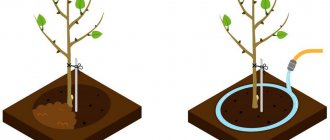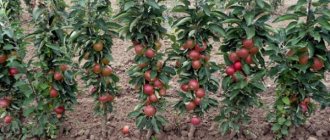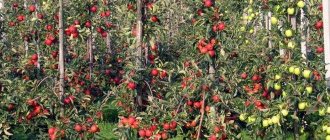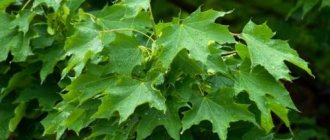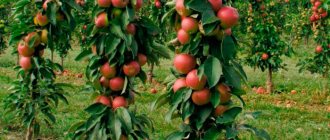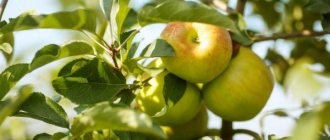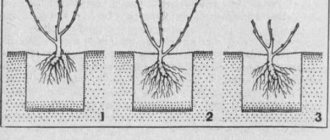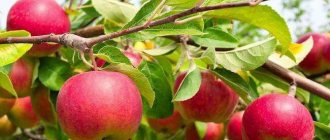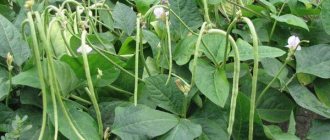Differences between columnar apple trees and ordinary ones
Columnar trees are not hybrids; the species was formed through natural mutation. The apple tree has a small number of lateral branches, the plant occupies a minimum area and produces a good harvest. The tree has a central conductor, from which branches form at an acute angle. The fruits ripen directly on the trunk, the apples are large and juicy. There are 2 types of columnar trees:
- varieties with the Co gene;
- simple species grafted onto dwarf rootstocks.
The productivity of an apple tree does not depend on the height of the central shoot. With proper care, the tree will bear fruit annually, the number of fruits corresponding to the varietal characteristics. The root system is close to the top layer of soil, so digging up the tree trunk circle is done carefully. According to the period of ripening, early, mid-ripening and late species are distinguished.
Important!
The first variety of columnar apple tree was bred in the 70s of the twentieth century, in Canada.
The best varieties
Successful planting of a columnar apple tree, as well as its further cultivation, largely depends on what seedlings you plant in the front garden. Therefore, it is advisable to buy planting material from specialized nurseries.
The fact is that if you buy such a tree from hand, there is a high probability of deception in the form of acquiring an ordinary variety grafted with a dwarf rootstock.
Well, as for such a question as the best varieties, they include the following types:
- early varieties, Amber Necklace;
- Bolero apple trees;
- Gin;
- Titania.
Important! The most common summer variety of columnar apple trees is Medoc. This culture is an honorary representative. It ripens at the end of summer and is highly resistant to frost, various defects and is well resistant to attacks by parasites.
In general, all the varieties described above have several common characteristics, namely:
- they are resistant to even the most severe frosts;
- the varieties described above can be safely planted in Western Siberia;
- the fruits of these crops are large and have excellent taste.
It is also worth highlighting that these varieties annually delight with stable yields starting from the first year of planting. The main thing is to choose the right time for planting crops.
Advantages and features of the new type
Miniature trees will help you create an original landscape design in your garden. Advantages of columnar varieties:
- Fruiting occurs 3-4 years after planting;
- space saving - fruit trees are compact and take up little space;
- the fight against diseases and pests, pruning, fertilizing is simplified;
- no special equipment is required for harvesting.
Disadvantages include a short fruiting period (10-15 years), special care requirements. The tree requires frequent watering and minimal pruning. The root system of the plant is underdeveloped and does not absorb water well. To prevent the apple tree from breaking during strong gusts of wind, it is necessary to install supports. It is impossible to remove a columnar tree from a normal one using grafting - the rootstocks are not suitable.
Preparatory work before planting
Apple trees can be grown in open ground, in a greenhouse, or in a container. The planting date is determined based on weather conditions - the tree needs 25-30 days to have time to take root. During the adaptation period there should be no sudden temperature changes or frosts. In central Russia, planting work is carried out in late September - early October. In the south of the country, columnar trees are planted from the middle of the second month of autumn, in the Urals - in early September.
Material selection
The climate in the regions of Russia differs significantly, so for planting it is recommended to choose varieties zoned for a specific region. The plant must be resistant to fungal diseases and sub-zero temperatures in winter. Rules for selecting seedlings:
- to purchase a high-quality specimen, it is better to buy apple trees in nurseries;
- annual plants take root faster;
- shoots and root system must be strong and healthy;
- If you purchase a tree in a container, you can take your time with planting.
An apple tree with an open root system is planted in the ground within 24 hours after purchase. The roots of the plant are placed in water before planting. When purchasing apple trees, you should give preference to species that are resistant to disease and natural stress. Popular productive varieties of columnar trees are Triumph, Gin, Amber Necklace, and President. The species Peasant, Barguzin, and Vasyugan are suitable for cultivation in Siberia.
Landing technology
It would be correct to plant a columnar apple tree in the fall in an area where there are no drafts or strong winds. The trees grow well on loamy and sandy soils. It is not recommended to plant apple trees in low-lying areas with low groundwater levels or on infertile soils. Before planting, dig up the soil and prepare a hole. Features of planting work depending on the type of soil:
Errors during landing
Gardeners often make mistakes. Many people do not know at what distance to plant columnar apple trees from each other, or how to properly grow trunks. Common omissions include:
- incorrect choice of location on the site (apple trees do not bear fruit well in the shade, so there is no need to place them next to tall trees);
- applying nitrogen fertilizers in the fall;
- neglect of insulation (after replanting, it is advisable to cover the tree trunk circle with spruce branches, it not only warms, but also retains snow);
- too deep or, conversely, shallow landing.
Mistakes can lead to the death of trees. In the process of growing columnar apple trees, you need to spray them against pests. Most varieties are susceptible to insect attack. Preventive treatments with 1% copper sulfate are mandatory for such trees.
Planting seedlings in the ground
In order for the tree to successfully take root, the root system of the plant is treated with Kornevin 2 days before planting. Follow the step by step guide:
- The pit is prepared 2-3 weeks before planting. Fertilizers are placed at the bottom - 0.4 kg of wood ash, 0.08 kg of potassium and superphosphate, 4 kg of compost or humus.
- The roots of the plant are placed in a pit; the root system or grafting site should protrude 5-7 cm above ground level. A wooden support is made nearby, deepening it into the ground by 0.3-0.5 m.
- The soil is compacted and the landing site is watered abundantly.
According to the instructions, columnar apple trees should be planted at a distance of 1-1.5 m in the fall. When planting in rows, 0.3-0.5 m are spaced between the trees. To improve the fertility of the soil, green manure is planted annually between the rows. Plants in the first year of life need weeding; no further action is required.
What time of year should I buy seedlings?
Fruit tree seedlings, including columnar varieties, are sold in both spring and autumn. But, as a rule, in the autumn the range of varieties is richer. And if you bought trees in the fall, you will need to keep them in proper form until spring. Security can be ensured in various ways:
- dig into the ground until spring;
- store in a container in the basement or on the balcony.
When choosing planting material, it is recommended to pay attention to the following:
- age of cuttings – ideally 1 year;
- appearance – 5 buds on the trunk, smooth bark;
- root system – branched, without damage;
- the presence of a graft - this is indicated by a noticeable thickening at the bottom of the cutting.
Columnar apple trees with a closed root system are an ideal option for transplanting into the ground. When transplanted, such seedlings are practically not exposed to stress and take root better.
If the root system of the cutting is open, then during transportation it must be wrapped in damp burlap. And when planting, such cuttings need to be placed in a humid environment for several hours.
The apple tree feels comfortable in sunny areas of the garden, not stagnant, well aerated and protected from drafts. Having chosen such a place in the garden, in the fall you need to start digging planting holes.
Care after landing
If you are planting a garden with many columnar trees, follow the planting pattern - alternating groups of summer and autumn fruiting plants. It is necessary to avoid dense plantings - if there is a lack of light, apple trees will grow poorly. To reduce moisture loss, the tree trunk circle is mulched with sawdust or peat.
Watering, loosening
The frequency of events depends on weather conditions. Apple trees are watered as the moisture dries. A layer of mulch will protect the soil from drying out, and the frequency of watering can be reduced. If autumn is dry, the plant is watered after 3-5 days. 2 weeks before the onset of stable frosts, water-recharging irrigation is carried out with a consumption of 1 bucket of water per seedling. The soil is loosened every time after irrigation - the procedure helps supply the roots with oxygen.
Important!
Drip irrigation ensures an even supply of moisture.
Feeding
If organic and mineral fertilizers were applied during planting, fertilizing is not required in the first year of the plant’s life. In subsequent years, substances are introduced into the tree trunk circle:
- in spring - nitrogen, rotted mullein;
- during the flowering period - nitrophoska, superphosphate;
- after harvesting - wood ash.
On depleted soils, you can use a different feeding scheme: during the period when sap flow begins - 10 liters of humus; during flowering – 0.3 kg of urea; after fruiting - ammonium nitrate (30 g) or a mixture of superphosphate and potassium. To provide additional nutrition, foliar feeding is used - 1 tbsp is scattered around the perimeter of the crown. wood ash. The information is given per 1 fruit tree.
Trimming
The peculiarity of the columnar apple tree is that the tree requires minimal pruning. In the first year of the plant's life, the procedure is not required. From the second year, the crown is formed - young shoots are cut into 2 buds. If side branches begin to grow, leave the longest one (20 cm), and shorten the rest. You should not touch the apical bud - the plant will bear fruit poorly and may die. It is recommended to carry out sanitary pruning in the fall, and shaping pruning in the spring.
Shelter for the winter
In order for the tree to successfully prepare for the winter season, a number of events are carried out in the fall. Cellophane is spread on the tree trunk circle, lichens are removed with a sharp object, and if necessary, the bark is cleaned. To protect against sunburn and frost damage, the boles are whitened with lime mortar (for 5 liters of water - 100 g of lime and wood glue, 250 g of iron sulfate).
Shelter for the winter is necessary to protect the tree from temperature changes, severe frosts, and rodent invasion. The method of covering depends on the region where the tree grows. In central Russia, it is enough to cover the root system, install supports around them and wrap them with burlap so that the apple tree does not break in windy weather. The tree trunk circle is covered with sawdust or peat, and spruce branches are placed on top.
Caring for Columnar Trees
In order for columnar fruit trees in the garden to delight with beautiful flowering and rich harvests, they need to be given attention at least once a season. Compared to tall ones, they are more capricious, but caring for such plants is greatly simplified due to their compactness.
Top dressing
During fruit ripening, trees absorb maximum nutrients from the soil, so their supply should be replenished annually. In the spring, humus, nitrogen and nitroammophoska are added under the roots, which promote active growth. In autumn, substances are used to increase winter resistance - phosphorus and potassium. The fertilizer rate is calculated based on the type and age of the tree, taking into account the instructions for each selected preparation.
Trimming
Fruit trees with a columnar crown are pruned as strong side branches appear on them - they are removed completely, covering the cuts with garden pitch. Too long shoots are shortened in the summer so that nutrients are directed to the fruits and not to the growth of the wood. In the fall, if necessary, the main trunk is shortened and branches that are too thick are cleared.
Preparing for winter
Since the roots of columnar trees are shallow, they must be protected from frost first. This is especially true for young seedlings and heat-loving stone fruit crops. To insulate the root zone, you can use fallen leaves, straw, and pine litter - air will penetrate through them, and during thaws the trunk will not rot. It is useful to put burlap or spruce branches on top. To prevent rodents from damaging the delicate bark, it makes sense to use a fine-mesh mesh. If severe frosts are coming, it would not hurt to protect the trees entirely by wrapping their trunks with padding polyester, paper, old clothes, or covering them with a special “tent”. If the upper bud of the trunk dies due to frost, the plant may lose its columnar shape and begin to grow side branches.
Popular gardening mistakes
To get a good harvest of columnar apple trees, do not repeat popular mistakes:
- Columnar trees are early-bearing, the first ovaries can form already in the first year of planting. It is better to cut off the flowers so that the tree has time to prepare for the new season.
- The foliage and last year's harvest have not been harvested - pests remain there for the winter.
- Using straw as a shelter - the material attracts rodents.
- The use of dense materials that impede oxygen access to wood - roofing felt, cellophane film. As the air temperature rises, the plant will sweat and then freeze.
- Lack of whitewashing - the apple tree will not be protected for the winter from frost damage and bark burns. The event is necessary for trees of any variety and age.
